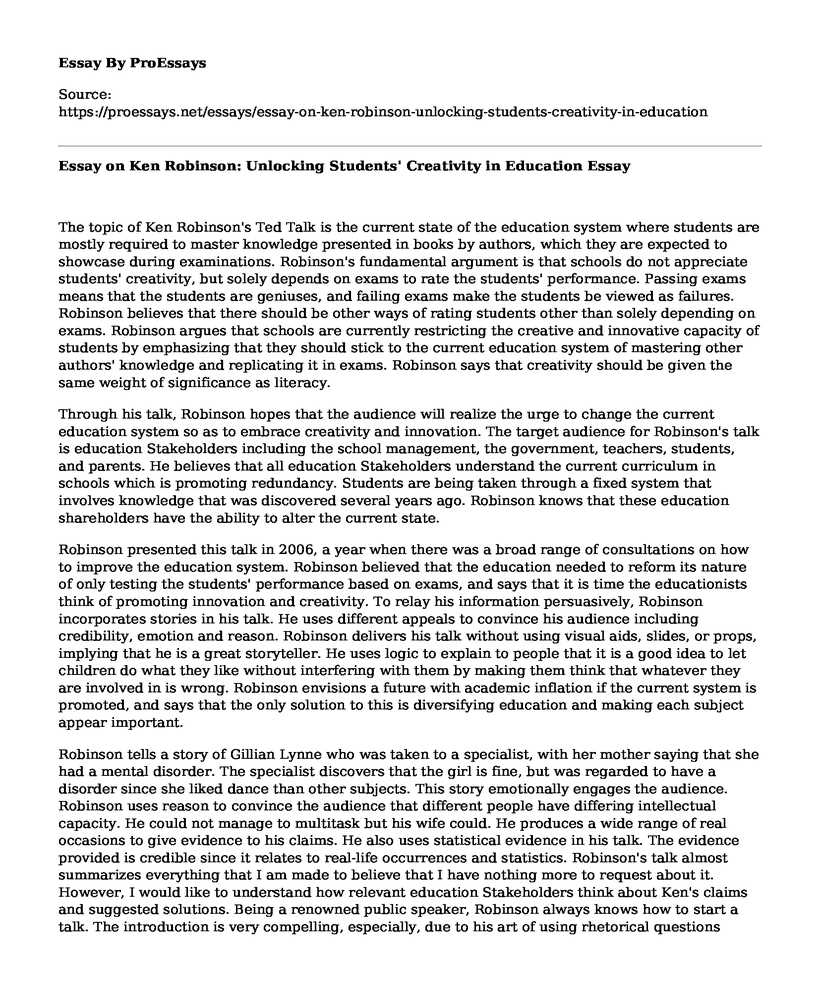The topic of Ken Robinson's Ted Talk is the current state of the education system where students are mostly required to master knowledge presented in books by authors, which they are expected to showcase during examinations. Robinson's fundamental argument is that schools do not appreciate students' creativity, but solely depends on exams to rate the students' performance. Passing exams means that the students are geniuses, and failing exams make the students be viewed as failures. Robinson believes that there should be other ways of rating students other than solely depending on exams. Robinson argues that schools are currently restricting the creative and innovative capacity of students by emphasizing that they should stick to the current education system of mastering other authors' knowledge and replicating it in exams. Robinson says that creativity should be given the same weight of significance as literacy.
Through his talk, Robinson hopes that the audience will realize the urge to change the current education system so as to embrace creativity and innovation. The target audience for Robinson's talk is education Stakeholders including the school management, the government, teachers, students, and parents. He believes that all education Stakeholders understand the current curriculum in schools which is promoting redundancy. Students are being taken through a fixed system that involves knowledge that was discovered several years ago. Robinson knows that these education shareholders have the ability to alter the current state.
Robinson presented this talk in 2006, a year when there was a broad range of consultations on how to improve the education system. Robinson believed that the education needed to reform its nature of only testing the students' performance based on exams, and says that it is time the educationists think of promoting innovation and creativity. To relay his information persuasively, Robinson incorporates stories in his talk. He uses different appeals to convince his audience including credibility, emotion and reason. Robinson delivers his talk without using visual aids, slides, or props, implying that he is a great storyteller. He uses logic to explain to people that it is a good idea to let children do what they like without interfering with them by making them think that whatever they are involved in is wrong. Robinson envisions a future with academic inflation if the current system is promoted, and says that the only solution to this is diversifying education and making each subject appear important.
Robinson tells a story of Gillian Lynne who was taken to a specialist, with her mother saying that she had a mental disorder. The specialist discovers that the girl is fine, but was regarded to have a disorder since she liked dance than other subjects. This story emotionally engages the audience. Robinson uses reason to convince the audience that different people have differing intellectual capacity. He could not manage to multitask but his wife could. He produces a wide range of real occasions to give evidence to his claims. He also uses statistical evidence in his talk. The evidence provided is credible since it relates to real-life occurrences and statistics. Robinson's talk almost summarizes everything that I am made to believe that I have nothing more to request about it. However, I would like to understand how relevant education Stakeholders think about Ken's claims and suggested solutions. Being a renowned public speaker, Robinson always knows how to start a talk. The introduction is very compelling, especially, due to his art of using rhetorical questions which keeps the audience following the conversation.
Robinson artily concludes his talk which gives a solution to an existing problem. Robinson believes that the problem with the current education is an overemphasis on particular subjects while demeaning others. He believes the solution to this problem is giving all subjects the same value. He finishes his speech by implying that he values the gift of human imagination and that people should view creativity as a gift and use it appropriately. Children should be educated wholly in preparation to face the uncertainty of the future.
References
Ken Robinson (2016, March 12). Do schools kill creativity- TED talks (English subtitles). Retrieved from http://youtu.be/tQzC7ubJriE
Cite this page
Essay on Ken Robinson: Unlocking Students' Creativity in Education. (2023, May 21). Retrieved from https://proessays.net/essays/essay-on-ken-robinson-unlocking-students-creativity-in-education
If you are the original author of this essay and no longer wish to have it published on the ProEssays website, please click below to request its removal:
- Research Paper Example on Language Use and Society Structure and Order
- Technology and Young Children Learning Essay
- Organization: Challenge-Cause Solution Paper Example
- Adverse Effects of Technology on Children
- Paper Example on Observing Preschool Class & Babysitting: A Fun & Rewarding Experience
- Essay Example on Preschool: A Foundation for Development & Interaction
- Free Paper Sample on Graduating Students: Overcome Job Challenges







